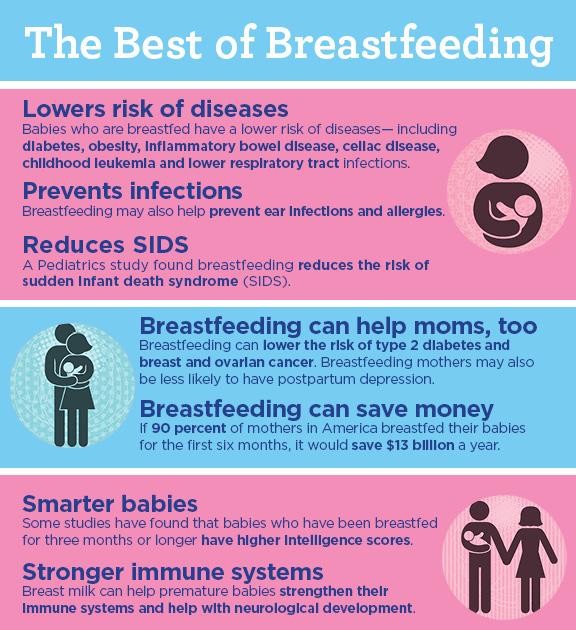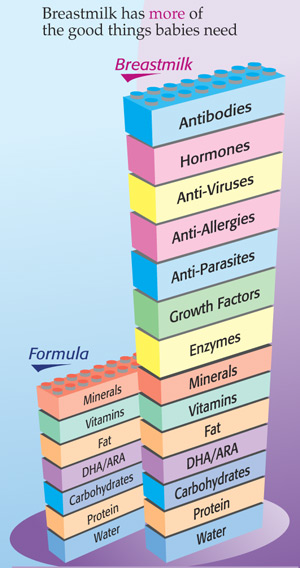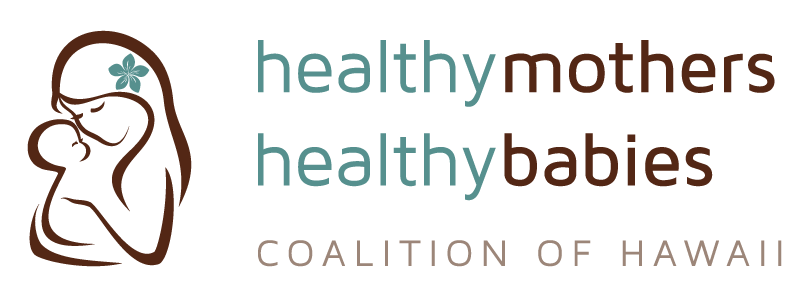Breastfeeding: Information for Mothers
The saying “Breast is Best” is true! In addition to the precious bonding time that breastfeeding affords, breastfeeding is natural, inexpensive, requires no special equipment, and lulls even the fussiest baby to sleep. If that’s not enough, the health benefits to both mother and baby are nothing short of amazing. It often takes some work in the beginning, but help is available and watching your healthy baby grow on breast milk is something to feel proud of.
Benefits for You
With no formula to buy and prepare or bottles and nipples to sterilize, breastfeeding is a money and time saver. In addition to savings on formula, nearly $1,000 in healthcare costs can be saved in baby’s first year by nursing. Plus, you’ll have a regularly scheduled time to relax and develop a deep bond with your baby.
The feelings of love, devotion and relaxation many moms report when nursing? Those feelings are aided by the release of oxytocin during breastfeeding, the same hormone released in the brain when you fall in love! It also helps your uterus shrink back to its pre-pregnancy state and may decrease the amount of bleeding you have after giving birth.
Breastfeeding can have long-term benefits as well. According to The American Academy of Obstetricians and Gynecologists, breastfeeding may reduce your risk of developing breast and ovarian cancer, and helps prevent osteoporosis and hip fracture later in life. For an added bonus, breastfeeding may help you shed some of those pounds gained during pregnancy!
Benefits for Baby
Breast milk has the optimal ratio of fat, sugar, water, protein, and minerals your baby needs for healthy growth and development. And as your infant grows, your breast milk adapts to meet the changing nutritional needs. That’s something formula can’t do!
Importantly, breastfeeding boosts your baby’s immune system to help protect against diseases and decrease the chances of developing earaches, colds, allergies, and lung infections. It also reduces the risk of Sudden Infant Death Syndrome, also known as SIDS or crib death.
Tummy upset can be a problem for newborns since their gastrointestinal tract is still developing. Breast milk encourages the growth of healthy bacteria in your baby’s gastrointestinal tract and inhibits the growth of other disease-causing bacteria. Because your baby is better able to digest breast milk than formula, breastfed babies have less constipation and diarrhea.
Children who are breastfed also have been shown to have fewer speech problems and straighter teeth, and numerous studies have shown enhanced language and emotional development in key parts of the brain.
Risks of NOT Breastfeeding
There are many benefits of breastfeeding, and unfortunately there are also some risks of not breastfeeding. Infants who are not breastfed are 10-15% more likely to be hospitalized before their first birthday. They also have higher risks for:
- Childhood obesity
- Ear infections
- Gastrointestinal illnesses
- Type 1 and Type 2 diabetes
- Leukemia
- Sudden Infant Death Syndrome (SIDS)
Mothers who do not breastfeed are at increased risk for :
- Breast cancer
- Ovarian cancer
- Type 2 diabetes
- Heart attack
- Metabolic syndrome
For more information and a free downloadable guide on breastfeeding, click here.
Common Breastfeeding Questions
Although breastfeeding is natural, many women have questions and need help getting started.
How do I know if I’m making enough milk? Is my baby getting enough to eat?
This is a very common question. A newborn’s stomach is only the size of a marble, and by 10 days old, is only the size of an egg! The fact that your baby constantly wants to eat is not a sign of under-production or that supplementation is necessary. Babies simply eat around the clock during their first months of life because their stomachs are very small and they digest breast milk very efficiently. You can expect major growth spurts approximately 4 weeks, 6 weeks and 4 months – just keep nursing, as you cannot overfeed a breastfed baby!
Find support and remember that it’s a “supply and demand” issue. The more often you put baby to your breast; the more milk you will make. Relax and trust yourself; your baby is helping build and sustain your milk production and supplementing with formula will compromise your supply. For a baby under 6 weeks old, six to eight wet diapers and two to five bowel movements in 24 hours means the baby is getting enough to eat. If you have more questions, consult the World Health Organization (WHO) child growth chart at your pediatrician’s office to ensure healthy, optimal weight gain.
Which is best: a manual or electric breast pump? Is it covered by insurance?
Your individual needs will determine the best type of pump is best for you, though working mothers who pump frequently find an electric pump is most helpful.
Starting July 1, 2012, private, commercial health insurance companies are required to provide a breast pump each time you’re pregnant, before of after you give birth. Contact your insurance company to learn their specific policies on breast pumps and for a list of participating providers or medical pharmacies.
What are my rights as a nursing mother?
Many women have reported feeling uncomfortable breastfeeding in public, even when doing so discreetly. But it’s important to remember that you are feeding your baby. You are not doing anything inappropriate. The federal government and the state of Hawaii have laws to protect your right to nurse in any public or private location of your choice:
HRS §489-21, HRS §489-22 Discriminatory practices; breastfeeding.
It is a discriminatory practice to deny, or attempt to deny, the full and equal enjoyment of the goods, services, facilities, privileges, advantages, and accommodations of a place of public accommodations to a woman because she is breastfeeding a child.
To download and print a wallet card outlining your right to breastfeed in public, click here.
What are my rights at work?
If you are employed by a company in Hawaii with 20 or more employees, your right to continue your breastfeeding relationship is protected by law. Effective July 1, 2013, employers are required to provide:
- A reasonable break time for you to express milk for your nursing child for one year after your child’s birth, each time you have a need to express breast milk.
- A location, other than the restroom, that is shielded from view and free from intrusion from coworkers and the public that you may use to express breast milk.
Federal law requires companies with 50 or more employees to comply with the same guidelines. To download the Breastfeeding in the Workplace labor law poster, click here.
Employers who fail to comply shall be fined $500 per violation and may be liable for damages. For more on the law, see the Hawaii Employment Practices Law (Act 249, 2013 Regular Session).
If you believe your employer has violated this law, you may file a lawsuit in state court within two years after the occurrence of the alleged violation. Damages may include reasonable attorney’s fees. For further assistance, contact the Hawaii State Bar Association Lawyer Referral and Information Service at 808-541-1361.


Learn More

Sources
1) Breastfeeding Benefits Your Baby’s Immune System, The American Academy of Pediatrics. Available at https://www.healthychildren.org/English/ages-stages/baby/breastfeeding/Pages/Breastfeeding-Benefits-Your-Babys-Immune-System.aspx.
2) FAQ- Breastfeeding Your Baby, The American College of Obstetricians and Gynecologists. Available at: https://www.acog.org/Patients/FAQs/Breastfeeding-Your-Baby
3) The Business Case for Breastfeeding, U.S. Department of Health and Human Services, Health Resources and Services Administration, Maternal and Child Health. Available at: http://mchb.hrsa.gov/pregnancyandbeyond/breastfeeding/.
4) Supporting Nursing Moms at Work: Employer Solutions, U.S. Department of Health and Human Services, Office on Women’s Health. Available at: http://www.womenshealth.gov/breastfeeding/employer-solutions/index.php.
5) Your Guide to Breastfeeding, U.S. Department of Health and Human Services, Office on Women’s Health. Available at: https://www.womenshealth.gov/files/documents/your-guide-to-breastfeeding.pdf.


